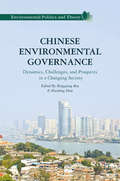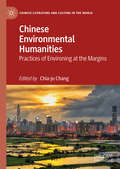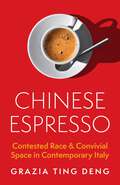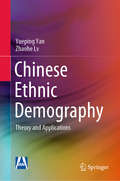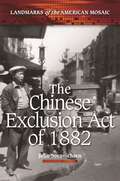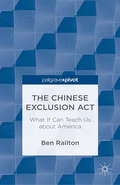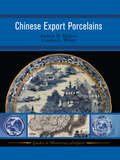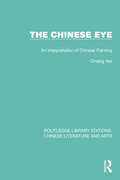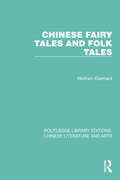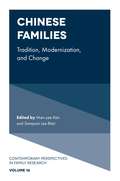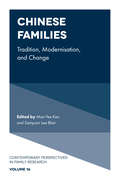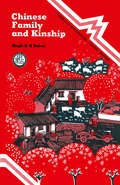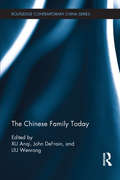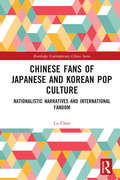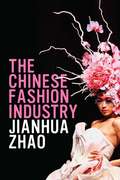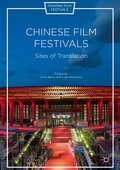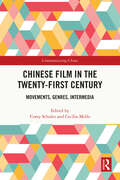- Table View
- List View
Chinese Environmental Governance: Dynamics, Challenges, and Prospects in a Changing Society (Environmental Politics and Theory)
by Bingqiang RenIn this edited volume, leading environmental policy experts from China, USA, and Europe provide a contemporary view of Chinese environmental policy, analyzing current discussions among various actors and agencies. The book covers a wide range of topics including the gap between national policy goals and their local implementation, cultural and social factors shaping political behavior, legal and political systems affecting environmental policy creation and execution, new societal forces participating in environmental policymaking and governance, and local state strategies tasked with navigating a mix of political, legal, and societal forces. Featuring in-depth, empirically-grounded analyses with interdisciplinary approaches, the book is ideal reading for scholars interested in the complex nature of balancing Chinese environmental sustainability and economic growth.
Chinese Environmental Humanities: Practices of Environing at the Margins (Chinese Literature and Culture in the World)
by Chia-Ju ChangChinese Environmental Humanities showcases contemporary ecocritical approaches to Chinese culture and aesthetic production as practiced in China itself and beyond. As the first collaborative environmental humanities project of this kind, this book brings together sixteen scholars from a diverse range of disciplines, including literary and cultural studies, philosophy, ecocinema and ecomedia studies, religious studies, minority studies, and animal or multispecies studies. The fourteen chapters are conceptually framed through the lens of the Chinese term huanjing (environment or “encircling the surroundings”), a critical device for imagining the aesthetics and politics of place-making, or “the practice of environing at the margin.” The discourse of environing at the margins facilitates consideration of the modes, aesthetics, ethics, and politics of environmental inclusion and exclusion, providing a lens into the environmental thinking and practices of the world’s most populous society.
Chinese Espresso: Contested Race and Convivial Space in Contemporary Italy
by Grazia Ting DengWhy and how local coffee bars in Italy—those distinctively Italian social and cultural spaces—have been increasingly managed by Chinese baristas since the Great Recession of 2008Italians regard espresso as a quintessentially Italian cultural product—so much so that Italy has applied to add Italian espresso to UNESCO&’s official list of intangible heritages of humanity. The coffee bar is a cornerstone of Italian urban life, with city residents sipping espresso at more than 100,000 of these local businesses throughout the country. And yet, despite its nationalist bona fides, espresso in Italy is increasingly prepared by Chinese baristas in Chinese-managed coffee bars. In this book, Grazia Ting Deng explores the paradox of &“Chinese espresso&”—the fact that this most distinctive Italian social and cultural tradition is being preserved by Chinese immigrants and their racially diverse clientele.Deng investigates the conditions, mechanisms, and implications of the rapid spread of Chinese-owned coffee bars in Italy since the Great Recession of 2008. Drawing on her extensive ethnographic research in Bologna, Deng describes an immigrant group that relies on reciprocal and flexible family labor to make coffee, deploying local knowledge gleaned from longtime residents who have come, sometimes resentfully, to regard this arrangement as a new normal. The existence of Chinese espresso represents new features of postmodern and postcolonial urban life in a pluralistic society where immigrants assume traditional roles even as they are regarded as racial others. The story of Chinese baristas and their patrons, Deng argues, transcends the dominant Eurocentric narrative of immigrant-host relations, complicating our understanding of cultural dynamics and racial formation within the shifting demographic realities of the Global North.
Chinese Espresso: Contested Race and Convivial Space in Contemporary Italy
by Grazia Ting DengWhy and how local coffee bars in Italy—those distinctively Italian social and cultural spaces—have been increasingly managed by Chinese baristas since the Great Recession of 2008Italians regard espresso as a quintessentially Italian cultural product—so much so that Italy has applied to add Italian espresso to UNESCO&’s official list of intangible heritages of humanity. The coffee bar is a cornerstone of Italian urban life, with city residents sipping espresso at more than 100,000 of these local businesses throughout the country. And yet, despite its nationalist bona fides, espresso in Italy is increasingly prepared by Chinese baristas in Chinese-managed coffee bars. In this book, Grazia Ting Deng explores the paradox of &“Chinese espresso&”—the fact that this most distinctive Italian social and cultural tradition is being preserved by Chinese immigrants and their racially diverse clientele.Deng investigates the conditions, mechanisms, and implications of the rapid spread of Chinese-owned coffee bars in Italy since the Great Recession of 2008. Drawing on her extensive ethnographic research in Bologna, Deng describes an immigrant group that relies on reciprocal and flexible family labor to make coffee, deploying local knowledge gleaned from longtime residents who have come, sometimes resentfully, to regard this arrangement as a new normal. The existence of Chinese espresso represents new features of postmodern and postcolonial urban life in a pluralistic society where immigrants assume traditional roles even as they are regarded as racial others. The story of Chinese baristas and their patrons, Deng argues, transcends the dominant Eurocentric narrative of immigrant-host relations, complicating our understanding of cultural dynamics and racial formation within the shifting demographic realities of the Global North.
Chinese Ethnic Demography: Theory and Applications
by Yueping Yan Zhaohe LvThis book focuses on the status quo and current trends concerning ethnic issues in China, and seeks to promote the equitable and harmonious development of Chinese and other nationalities around the world. Drawing on representative empirical studies and case studies, it describes the spatial structure and evolution of China’s populace, and analyzes the distribution of and legislation on its spatial development, which has been conducive to the scientific formulation of national population policies. After assessing the development of China’s populace, the book analyzes the future prospects with regard to achieving the goal of a prosperous society and balancing the population in a comprehensive way; puts forward some constructive suggestions on the modernization of the populace; and constructs a new knowledge system for national development with Chinese characteristics. The book combines qualitative and quantitative analysis and employs empirical, speculative, comparative, and comprehensive methods to make full use of modern science and technology, so as to promote ethnological research into a broader development path. Its goal is to objectively evaluate the development of the Chinese populace and provide objective facts and data to support those readers who are interested in its nature and evolution.
The Chinese Exclusion Act of 1882 (Landmarks of the American Mosaic)
by John SoennichsenThis in-depth examination of the Chinese Exclusion Act of 1882 provides a chronological review of the events, ordinances, and pervasive attitudes that preceded, coincided with, and followed its enactment.The Chinese Exclusion Act of 1882 was a historic act of legislation that demonstrated how the federal government of the United States once openly condoned racial discrimination. Once the Exclusion Act passed, the door was opened to further limitation of Asians in America during the late 19th century, such as the Scott Act of 1888 and the Geary Act of 1892, and increased hatred towards and violence against Chinese people based on the misguided belief they were to blame for depressed wage levels and unemployment among Caucasians.This title traces the complete evolution of the Exclusion Act, including the history of Chinese immigration to the United States, the factors that served to increase their populations here, and the subsequent efforts to limit further immigration and encourage the departure of the Chinese already in America.
The Chinese Exclusion Act: What It Can Teach Us about America
by B. RailtonThis book explores two critical strands in American Studies: policy conversations on legal and illegal immigration and social and educational conversations on diversity and multiculturalism. As author Benjamin Railton shows, a fresh look at the Chinese Exclusion Act overturns much of the received wisdom on immigration and American identity.
Chinese Export Porcelains
by Carolyn White Andrew D MadsenThe blue and white porcelain exported by China in the eighteenth and early nineteenth centuries is an important category of artifacts and antiques, a fashion-sensitive commodity that was affected by the ebbs and flows of style and consumer demand. In this copiously illustrated, comprehensive guide to Chinese export porcelain, Andrew Madsen offers both a broad overview and detailed identification and context information for the most common styles and motifs. His focus on the determination of manufacture dates, which are based primarily on data collected from armorial decorated export wares, porcelain cargoes from dated shipwrecks, and tightly dated archaeological contexts, will allow students, scholars, and collectors to refine associations with Chinese export porcelain, revealing the untapped quantity of information that mass-produced Chinese export porcelain has to offer.
Chinese Export Porcelains (Guides To Historical Artifacts Ser. #1)
by Carolyn White Andrew D MadsenThe blue and white porcelain exported by China in the eighteenth and early nineteenth centuries is an important category of artifacts and antiques, a fashion-sensitive commodity that was affected by the ebbs and flows of style and consumer demand. In this copiously illustrated, comprehensive guide to Chinese export porcelain, Andrew Madsen offers both a broad overview and detailed identification and context information for the most common styles and motifs. His focus on the determination of manufacture dates, which are based primarily on data collected from armorial decorated export wares, porcelain cargoes from dated shipwrecks, and tightly dated archaeological contexts, will allow students, scholars, and collectors to refine associations with Chinese export porcelain, revealing the untapped quantity of information that mass-produced Chinese export porcelain has to offer.
The Chinese Eye: An Interpretation of Chinese Painting (Routledge Library Editions: Chinese Literature and Arts #6)
by Chiang YeeThis book, first published in 1935, examines the world of Chinese painting: the background, styles, audience and reception, intentions and achievements. Written with a Western readership in mind, it intends to put Chinese visual art in the perspective of its history and culture, and clarify its ideas and meanings.
The Chinese Eye: An Interpretation of Chinese Painting (Routledge Library Editions: Chinese Literature and Arts #6)
by Chiang YeeThis book, first published in 1935, examines the world of Chinese painting: the background, styles, audience and reception, intentions and achievements. Written with a Western readership in mind, it intends to put Chinese visual art in the perspective of its history and culture, and clarify its ideas and meanings.
Chinese Fairy Tales and Folk Tales (Routledge Library Editions: Chinese Literature and Arts #7)
by Wolfram EberhardThis book, first published in 1937, collects together traditional Chinese fairy tales, taken down word for word as they were related to the author by one of China’s foremost scholars.
Chinese Fairy Tales and Folk Tales (Routledge Library Editions: Chinese Literature and Arts #7)
by Wolfram EberhardThis book, first published in 1937, collects together traditional Chinese fairy tales, taken down word for word as they were related to the author by one of China’s foremost scholars.
Chinese Families: Tradition, Modernization, and Change (Contemporary Perspectives in Family Research #16)
by Man-Yee Kan Sampson Lee BlairOver the past half of a century, Chinese societies have undergone a tremendous amount of social, political, and economic change, which have also been a catalyst for substantial shifts in fundamental structures and processes within Chinese families. This edited collection focuses on the continuities and changes in gender and intergenerational relations of Chinese families in Greater China. Paying close attention to families in Greater China, including the People’s Republic of China, Hong Kong, and Taiwan, the authors address a wide array of topics, including marriage patterns, cohabitation, rural-urban variations in family structures, fertility aspirations, spousal relationships and marital quality, and more. Collectively, the chapters point to the dynamic, diverse, and evolving nature of Chinese families, and also provide considerable insight into their future trajectories.
Chinese Families: Tradition, Modernization, and Change (Contemporary Perspectives in Family Research #16)
by Man-Yee Kan and Sampson Lee BlairOver the past half of a century, Chinese societies have undergone a tremendous amount of social, political, and economic change, which have also been a catalyst for substantial shifts in fundamental structures and processes within Chinese families. This edited collection focuses on the continuities and changes in gender and intergenerational relations of Chinese families in Greater China. Paying close attention to families in Greater China, including the People’s Republic of China, Hong Kong, and Taiwan, the authors address a wide array of topics, including marriage patterns, cohabitation, rural-urban variations in family structures, fertility aspirations, spousal relationships and marital quality, and more. Collectively, the chapters point to the dynamic, diverse, and evolving nature of Chinese families, and also provide considerable insight into their future trajectories.
The Chinese Family Today (Routledge Contemporary China Series)
by Anqi Xu John DeFrain Wenrong LiuThe Chinese economy is undergoing dramatic changes and the world is watching and changing along with it. The Chinese family is also changing in many ways in response to the economic transformation that is moving the world’s most populous nation from an agrarian economy to a global superpower. This is the first book in English to describe and explain the social transformation of the Chinese family from the perspective of Chinese researchers. Presenting a comprehensive view of the Chinese family today and how it has adapted during the process of modernization, it provides description and analysis of the trajectory of changes in family structures, functions, and relationships. It tracks how Chinese marriages and families are becoming more diverse and face a great deal of uncertainty as they evolve in different ways from Western marriages and families. The book is also unique in its use of national statistics and data from large-scale surveys to systematically illustrate these radical and extraordinary changes in family structure and dynamics over the past 30 years. Demonstrating that the de-institutionalization of family values is a slow process in the Chinese context, this book will be of interest to students and scholars of Chinese Studies, Sociology, Social Policy and Family Policy.
The Chinese Family Today (Routledge Contemporary China Series)
by XU Anqi, John DeFrain, and LIU WenrongThe Chinese economy is undergoing dramatic changes and the world is watching and changing along with it. The Chinese family is also changing in many ways in response to the economic transformation that is moving the world’s most populous nation from an agrarian economy to a global superpower. This is the first book in English to describe and explain the social transformation of the Chinese family from the perspective of Chinese researchers. Presenting a comprehensive view of the Chinese family today and how it has adapted during the process of modernization, it provides description and analysis of the trajectory of changes in family structures, functions, and relationships. It tracks how Chinese marriages and families are becoming more diverse and face a great deal of uncertainty as they evolve in different ways from Western marriages and families. The book is also unique in its use of national statistics and data from large-scale surveys to systematically illustrate these radical and extraordinary changes in family structure and dynamics over the past 30 years. Demonstrating that the de-institutionalization of family values is a slow process in the Chinese context, this book will be of interest to students and scholars of Chinese Studies, Sociology, Social Policy and Family Policy.
Chinese Fans of Japanese and Korean Pop Culture: Nationalistic Narratives and International Fandom (Routledge Contemporary China Series)
by Lu ChenHow can Japanese popular culture gain numerous fans in China, despite pervasive anti-Japanese sentiment? How is it that there’s such a strong anti-Korean sentiment in Chinese online fan communities when the official Sino-Korean relationship is quite stable before 2016? Avid fans in China are raising hundreds of thousands of dollars in funding to make gifts to their idols in foreign countries. Tabloid reports on Japanese and Korean celebrities have been known to trigger nationalist protests in China. So, what is the relationship between Chinese fandom of Japanese and Korean popular culture and nationalist sentiment among Chinese youth? Chen discusses how Chinese fans of Japanese and Korean popular culture have formed their own nationalistic discourse since the 1990s. She argues that, as nationalism is constructed from various entangled ideologies, narratives, myths and collective memories, popular culture simply becomes another resource for the construction of nationalism. Fans thus actively select, interpret and reproduce the content of cultural products to suit their own ends. Unlike existing works, which focus on the content of transnational cultural flows in East Asia, this book focuses on the reception and interpretation of the Chinese audience.
Chinese Fans of Japanese and Korean Pop Culture: Nationalistic Narratives and International Fandom (Routledge Contemporary China Series)
by Lu ChenHow can Japanese popular culture gain numerous fans in China, despite pervasive anti-Japanese sentiment? How is it that there’s such a strong anti-Korean sentiment in Chinese online fan communities when the official Sino-Korean relationship is quite stable before 2016? Avid fans in China are raising hundreds of thousands of dollars in funding to make gifts to their idols in foreign countries. Tabloid reports on Japanese and Korean celebrities have been known to trigger nationalist protests in China. So, what is the relationship between Chinese fandom of Japanese and Korean popular culture and nationalist sentiment among Chinese youth? Chen discusses how Chinese fans of Japanese and Korean popular culture have formed their own nationalistic discourse since the 1990s. She argues that, as nationalism is constructed from various entangled ideologies, narratives, myths and collective memories, popular culture simply becomes another resource for the construction of nationalism. Fans thus actively select, interpret and reproduce the content of cultural products to suit their own ends. Unlike existing works, which focus on the content of transnational cultural flows in East Asia, this book focuses on the reception and interpretation of the Chinese audience.
The Chinese Fashion Industry: An Ethnographic Approach (Dress, Body, Culture)
by Jianhua ZhaoLess than three decades ago, when the Chinese bought cloth or clothes, they would have had to use a government-issued coupon. Today the Chinese fashion industry is one of the most dynamic in the world - it not only supplies fashions to the increasingly discerning domestic market, but also provides one-third of the clothing sold in the global market. How did this phenomenal transition come about? What can the growth of the Chinese fashion industry tell us about the post-Mao China? What roles do the local and the global play in the dramatic changes? This book offers a historically informed, ethnographically grounded and interpretive analysis of contemporary Chinese fashion and the fashion industry. It examines the interplay of state politics, market forces, local social and cultural factors, and the global political economy, both in the rise of the Chinese fashion industry and in the life and work of Chinese fashion professionals. As the first ethnographic account of the Chinese fashion industry in the post-Mao era, The Chinese Fashion Industry combines first-hand accounts with sophisticated cultural analysis to offer new insights, and will be of interest to students and scholars of fashion, anthropology and China.
The Chinese Fashion Industry: An Ethnographic Approach (Dress, Body, Culture)
by Jianhua ZhaoLess than three decades ago, when the Chinese bought cloth or clothes, they would have had to use a government-issued coupon. Today the Chinese fashion industry is one of the most dynamic in the world - it not only supplies fashions to the increasingly discerning domestic market, but also provides one-third of the clothing sold in the global market. How did this phenomenal transition come about? What can the growth of the Chinese fashion industry tell us about the post-Mao China? What roles do the local and the global play in the dramatic changes? This book offers a historically informed, ethnographically grounded and interpretive analysis of contemporary Chinese fashion and the fashion industry. It examines the interplay of state politics, market forces, local social and cultural factors, and the global political economy, both in the rise of the Chinese fashion industry and in the life and work of Chinese fashion professionals. As the first ethnographic account of the Chinese fashion industry in the post-Mao era, The Chinese Fashion Industry combines first-hand accounts with sophisticated cultural analysis to offer new insights, and will be of interest to students and scholars of fashion, anthropology and China.
Chinese Film Festivals: Sites of Translation (Framing Film Festivals)
by Chris Berry Luke RobinsonThis book is the first anthology of research devoted to the booming world of Chinese film festivals, covering both mainstream and independent films. It also explores festivals in the Chinese-speaking world and festivals of Chinese films in the rest of the world. The book asks how Chinese film festivals function as sites of translation, translating Chinese culture to the world and world culture to Chinese-speaking audiences, and also how the international film festival model is being transformed as it is translated into the Chinese-speaking world.
Chinese Film in the Twenty-First Century: Movements, Genres, Intermedia (Communicating China)
by Corey Schultz Cecília MelloThis book examines Chinese film in the twenty-first century. Organized around the themes "movements," "genres," and "intermedia," it reflects on how Chinese cinema has changed, adapted, and evolved over past decades and prognosticates as to its future trajectories. It considers how established film genres in China have adapted and transformed themselves, and discusses current shifts in documentary filmmaking, the ethos and practices of "grassroots intellectual" independent filmmakers, and the adaption of foreign film genres to serve the ideological and political needs of the present. It also explores how film is drawing on the socio-historical and political contexts of the past to create new cinematic discourses and the ways film is providing a voice to previously marginalised ethnic groups. In addition, the book analyses the influences of past aesthetic traditions on the creative and artistic expressions of twenty-first-century films and cinema’s relation to other media forms, including folktales, moving image installations, architecture, and painting. Throughout, the book assesses how Chinese films have been conceptualized, examined, and communicated domestically and abroad and emphasizes the importance of new directions in Chinese film, thus highlighting the plurality, vitality, and hybridity of Chinese cinema in the twenty-first century.
Chinese Film in the Twenty-First Century: Movements, Genres, Intermedia (Communicating China)
This book examines Chinese film in the twenty-first century. Organized around the themes "movements," "genres," and "intermedia," it reflects on how Chinese cinema has changed, adapted, and evolved over past decades and prognosticates as to its future trajectories. It considers how established film genres in China have adapted and transformed themselves, and discusses current shifts in documentary filmmaking, the ethos and practices of "grassroots intellectual" independent filmmakers, and the adaption of foreign film genres to serve the ideological and political needs of the present. It also explores how film is drawing on the socio-historical and political contexts of the past to create new cinematic discourses and the ways film is providing a voice to previously marginalised ethnic groups. In addition, the book analyses the influences of past aesthetic traditions on the creative and artistic expressions of twenty-first-century films and cinema’s relation to other media forms, including folktales, moving image installations, architecture, and painting. Throughout, the book assesses how Chinese films have been conceptualized, examined, and communicated domestically and abroad and emphasizes the importance of new directions in Chinese film, thus highlighting the plurality, vitality, and hybridity of Chinese cinema in the twenty-first century.
